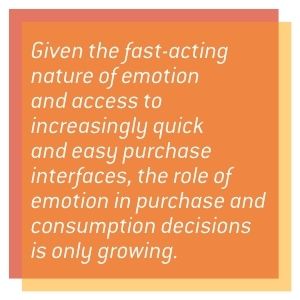Your Customers Make Decisions Emotionally: How Emotional Data & Analytics Improve Customer Experience
By Jay Yeo, Consultant, ORI
It is no great revelation to say that emotion impacts decision making. Yet organizations often overlook this truth when it comes to how their customers make decisions about them. Why is this? What stands to be gained by paying attention to emotions? And how can organizations capture and analyze emotion to benefit their customers and themselves?
Why Do We Overlook Emotion?
Historically, emotion was viewed as playing an integral role in decision making. Participating in something because of a feeling it would lead to a positive outcome (or avoiding something because of a negative feeling) was considered a sensible and legitimate way to make decisions.
This began to shift particularly during the Enlightenment period, when emphasis was placed on rationality and science, which were thought to be contradictory to emotion. The benefits of rationality and science became apparent as we learned more about the world in which we live and our place in it, invented innovative technologies, and found new ways to create social, political, and economic order and structures.
Despite the great gains of this newfound focus on rationality and science, the importance and role of emotion in our daily lives and how we make decisions never disappeared. In fact, some of history’s greatest thinkers, scientists, and theorists have attested that emotion continues to shape our decisions even when we utilize rational thought. Though we have favored rational and scientific thought since the Enlightenment, emotion has always shaped and will continue to shape how we make decisions.
Why Should Organizations Pay Attention to Emotion?
Emotion’s ongoing relevance and importance is also supported in contemporary scientific literature on emotion and customer behavior. As evidenced in Michel Pham’s research on consumer behavior in Representativeness, Relevance, and the Use of Feelings in Decision Making  and Selectively Emotional: How Smartphone Use Changes User-Generated Content, the quick acting, intuitive nature of emotion and “gut feelings” is even more pronounced when making consumptive decisions. Given the fast-acting nature of emotion and access to increasingly quick and easy purchase interfaces, the role of emotion in purchase and consumption decisions is only growing.
and Selectively Emotional: How Smartphone Use Changes User-Generated Content, the quick acting, intuitive nature of emotion and “gut feelings” is even more pronounced when making consumptive decisions. Given the fast-acting nature of emotion and access to increasingly quick and easy purchase interfaces, the role of emotion in purchase and consumption decisions is only growing.
Emotion also plays a critical role in what people choose to share with others, whether by word of mouth, social media, or review sites. As Chevalier and Mayzlin demonstrate in their article The Effect of Word of Mouth on Sales: Online Book Reviews, the impact of emotion is dispersed throughout networks with potentially far-reaching reverberations, particularly as it becomes easier to share information quickly with a wide audience on platforms like Twitter, Instagram, and Facebook, as shown by Pham. The sharing of emotion is compounded as viewers react to other customers’ comments and posts, which also have an emotional effect that drives behavior. Emotion is not just critical to decision making. It has a ripple effect that touches other customers, prospects, and the general public.
Despite the clear importance of emotion in decision making, we still carry the historical baggage of the deceptive split between rationality and emotion, and we favor the rational in looking for reasons and causes for why people make their decisions. Ignoring or downplaying the role of emotion misses one of the key drivers of customers’ decisions and prevents organizations from truly knowing their customers, what they want and need, and how they want and need it. In the end, it hinders them from actualizing their customer experience (CX) and revenue potential.
How Can Organizations Use Data & Analytics to Understand Customer Emotion?
Because emotion is so critical in decision making, understanding how customers feel and why they feel that way enables organizations to make informed decisions that impact CX and the bottom line. Unlike other types of data that come in relatively clear-cut numerical ratings, dollars spent, posts created, and satisfaction scores, emotional data has historically been difficult to capture and analyze. Traditionally, emotional data has been collected by asking customers to rate different emotions or select pre-determined responses from a list. While this method of asking closed-ended questions can provide some insight, it is necessarily limited and runs into a few key obstacles:
- Leading the Witness: Structured questions often have at least a slight bias that inclines respondents to answer in a particular way. This prevents organizations from gathering accurate and reliable data to guide decisions.
- Prioritizing Organizational Goals over Customer Goals & Experience: Pre-determined structured questions require that organizations pick topics, emotions, or themes to ask about—which are therefore reflective of organizational priorities (or an interpretation of customers’ top concerns) rather than customers’ own stated priorities. This can be helpful in cases where a particular topic or aspect is known to be critical to CX and the bottom line. But by failing to provide an opportunity for customers to voice their own thoughts, organizations stand to miss other key areas of interest.
- Not Effectively Linking Emotion to a Cause: While organizations may ask about emotion in structured survey questions, for example, it is difficult to link these findings to a cause, especially while keeping surveys brief and user-friendly to maximize response rates.
- Missing the Multitude of Emotional Data Sources: When organizations use only surveys or questionnaires to ask direct questions about emotion, other sources that are rich in emotional data and highly utilized by customers are ignored (e.g., ratings and reviews, social media, and online community forums). This method provides insight into a fraction of customers and misses wide swaths of rich data contained in the broader array of sources and platforms being used by customers.
Using Text Analytics Solutions to Tap into Customer Emotion
Text analytics solutions avoid many of the potential pitfalls of analyzing closed-ended questions for emotional data. They also provide deep insight into customers’ emotions as well as the drivers and behavioral outcomes of those emotions. Open-ended text sources (e.g., ratings and reviews, social media, open-ended survey feedback, and online community forums) allow customers to voice what is most important to them using their own words, creating a treasure trove of emotionally rich data. High-quality advanced text analytics tools that can detect themes, subthemes, sentiment, emotion, and effort can be used to parse this data to identify drivers of emotion and help organizations improve CX and maximize bottom-line impact.
Because customers may have different emotional responses based on factors not mentioned directly in their feedback (e.g., geography, age, purchase history, social media engagement, education level, job title, and gender), pairing open-ended feedback with structured data helps identify difficult-to-spot correlations between emotions and customer behavior, demographics, or psychographics. Combining structured data with open-ended commentary also allows organizations to understand how emotions affect customer behavior by tracking them over time along with the behaviors, purchase decisions, and engagement practices resulting from different emotions.
With the increasing availability of high-quality advanced text analytics solutions, organizations can overcome the tendency to overemphasize the rational and instead understand customers’ emotions, the drivers behind them, and their effects on decision making for improved CX and revenue potential.












